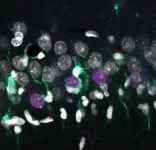(Press-News.org) Amyotrophic lateral sclerosis (ALS) is a severe, fatal neurodegenerative disorder causing loss of motor neurons and voluntary muscle action. While mouse studies have identified potential treatments, these drugs have typically done very poorly in human trials. Researchers at Boston Children's Hospital, working in collaboration with Pfizer, now report a high-throughput target and drug discovery platform using motor neurons made from ALS patients. Using the platform, they confirmed two known targets and identified an existing class of drugs -- agonists to the dopamine D2 receptor -- as potential novel treatments.
The researchers, led by Clifford Woolf, MD, PhD, director of the F.M. Kirby Neurobiology Center at Boston Children's, and first authors Xuan Huang, PhD, and Kasper Roet, PhD, in Woolf's lab, describe the platform and their findings June 8 in the journal Cell Reports.
To create the motor neurons used for drug screening, the team used induced pluripotent stem cells, made by the lab of Kevin Eggan at Harvard University from tissue samples of patients with ALS who carried the SOD1(A4V) mutation. The Woolf lab also developed a high-throughput, live-cell imaging technology to measure the motor neurons' hyperexcitability -- the tendency to "fire" excessively -- before and after exposure to candidate drugs. Woolf and colleagues previously showed that human motor neurons with ALS mutations are more excitable than normal motor neurons.
"This hyperexcitability makes the motor neurons more susceptible to degeneration and ultimately death," says Woolf. "Our imaging platform is able to rapidly evaluate hyperactivity in 384-well plates of motor neurons and test the cells' response to thousands of different drugs."
The technology, called GCaMP imaging, had not been used on a mass scale before for ALS. GCaMP is a fluorescent reporter of calcium levels in the neurons, an indicator of how frequently the neurons are firing action potentials.
In all, the researchers screened a library of 2,900 drugs from Pfizer with known, annotated actions. After three rounds of screening, they found 67 compounds that reduced the hyperexcitability of the patient-derived motor neurons, without causing toxicity.
"By doing a screen aimed at reversing the ALS motor neuron disease phenotype -- namely, hyperexcitability -- we were able to discover new targets and disease mechanisms and confirm others in an unbiased way," says Woolf.
Further investigations homed in on 13 potential drug targets with the greatest effects, seven of which belonged to two classes (AMPA receptors and Kv7 potassium channels) already known to be associated with ALS hyperexcitability. Kv7 channel-opening drugs were found to decrease motor neuron hyperexcitability in ALS in a recent clinical trial. QurAlis, a company co-founded by Woolf, Eggan, and Roet, is developing these drugs as therapies for ALS.
The current study also found a promising new class of candidate drugs, agonists to the dopamine D2 receptor (DRD2). These receptors' role in motor neuron hyperexcitability had not previously been recognized. Some DRD2 agonists (bromocriptine, sumanirole) are commercially available, opening the possibility of using them in patients with ALS.
"Our results show that neuronal excitability screens are a powerful platform for discovery of relevant, druggable targets," says Woolf. "We believe it can be applied to other neurological diseases that involve neuronal excitability, such as epilepsy and other neurodegenerative disorders like Alzheimer's disease."
Woolf is continuing to use human neuron screening platforms to identify novel targets for treating pain and neuropathy.
"One of the most difficult challengers in drug discovery is identifying a target that has a key role in the disease process," he says. "Using patient-derived neurons to model disease and test large sets of compounds whose targets are known can be the driver for developing new therapies."
INFORMATION:
This study was funded by Target ALS, Pfizer Centers for Therapeutic Innovation (CTI), an ALSA Milton Safenowitz postdoctoral fellowship, and the National Institutes of Health. The authors declare the following competing financial interests: Roet, Woolf, and Eggan are founders of QurAlis Corporation. Roet is CEO of QurAlis. Coauthors Liying Zhang, Amy Brault, Allison Berg, Anne Jefferson, Jackie Klug-McLeod, Karen Leach, Fabien Vincent, Hongying Yang, Anthony Coyle, and Lyn Jones are current or previous employees of Pfizer Inc.
About Boston Children's Hospital
Boston Children's Hospital is ranked the #1 children's hospital in the nation by U.S. News & World Report and is the primary pediatric teaching affiliate of Harvard Medical School. Home to the world's largest research enterprise based at a pediatric medical center, its discoveries have benefited both children and adults since 1869. Today, 3,000 researchers and scientific staff, including 9 members of the National Academy of Sciences, 23 members of the National Academy of Medicine and 12 Howard Hughes Medical Investigators comprise Boston Children's research community. Founded as a 20-bed hospital for children, Boston Children's is now a 415-bed comprehensive center for pediatric and adolescent health care. For more, visit our Answers blog and follow us on social media @BostonChildrens, @BCH_Innovation, Facebook and YouTube.
A multidisciplinary team led by researchers from the Spanish Research Council (CSIC) identifies the genomic cellular map associated with hippocampal sclerosis, a major histopathological condition of temporal lobe epilepsy. The study, published in Cell Reports, identifies cell-type specific transcriptional signatures of hyper-excitability and neurodegeneration, providing grounds for improved diagnosis. While the presence of sclerosis is essential for identifying temporal lobe epilepsy (the most common form of drug-resistant epilepsy), it is also detected in some cases of dementia associated ...
Since March 2020 the Cancer Genomics and BioComputing of Complex Diseases Laboratory at the Azrieli Faculty of Medicine of Bar-Ilan University has been dedicated to the study of COVID-19. Motivated in particular to study the evolution of coronaviruses, the lab, led by Dr. Milana Frenkel-Morgenstern, has characterized and compared sequences of numerous relevant viruses.
In their most recent study, published in the journal of the Federation of European Biochemical Societies (FEBS), the research team focused on patterns of genetic coding used by viruses which infect a single or narrow range of hosts compared to those which infect a multiple or broad range of hosts.
It was discovered that "promiscuous", or multiple-host, viruses utilize significantly non-optimal codons (the DNA ...
Mobility analyses show: Only a small proportion of all vehicles are responsible for the majority of the kilometers driven. We are talking above all about long-distance trucks that transport goods all over Europe. If these continue to be fueled with fossil energy, it will hardly be possible to sufficiently reduce CO2 emissions in road traffic. Synthetic fuels from surplus renewable electricity can make a significant contribution to such frequent driver applications.
With electric mobility, hydrogen mobility and synthetic fuels, Empa's future mobility demonstrator, "move", is investigating ...
In a first-of-its-kind study, researchers from Tel Aviv University and the Academic College of Tel Aviv-Yaffo used smart watches and a dedicated app to monitor 169 subjects before and during Israel's second COVID-19 lockdown (October 2020). The watches and app provided the researchers with accurate daily data for measuring quality of life parameters, such as mood, stress, duration and quality of sleep, heart rate at rest, meeting others and physical exercise.
The study was conducted by a group of experts from the Iby and Aladar Fleischman Faculty of Engineering at Tel Aviv University led by Dr. Erez Shmueli, Dr. Dan Yamin, Shay Oved and Merav Mofaz, in collaboration with TAU's Prof. Noga Kronfeld Schor of the School of Zoology at the George S. Wise ...
BOSTON - Last year, people who smoked had a variety of responses to the COVID-19 pandemic, with some increasing their smoking to help them cope and others quitting to potentially lessen their vulnerability to COVID-19. That's the finding of new research published in the Journal of General Internal Medicine and conducted by investigators at Massachusetts General Hospital (MGH), Vanderbilt University Medical Center and the University of Pittsburgh School of Medicine.
"Studies have shown that alcohol and opioid use increased during the pandemic, but little is known about how smokers responded," says lead author Nancy A. Rigotti, MD, director of MGH's Tobacco Research and Treatment Center and professor of Medicine at Harvard Medical School. "They might have increased ...
Rising temperatures are increasingly affecting the quality of life in many regions, setting new challenges for architects, urban planners and healthcare systems. Researchers at KAUST have analyzed discomfort due to outdoor heat across Saudi Arabia and neighboring regions to help understand and combat the problem.
"Living conditions in the Kingdom have been particularly affected by the changing climate," says Hari Dasari, first author of the paper. He also emphasizes the unique challenges facing the Hajj pilgrimage visits by several million people each year. Between 2014 and 2018, the Hajj occurred in summer months when the ...
UNF archaeology researchers are uncovering the lost Indigenous NE Florida settlement of Sarabay
Jacksonville, Fla. - The University of North Florida archaeology team is now fairly confident they have located the lost Indigenous northeast Florida community of Sarabay, a settlement mentioned in both French and Spanish documents dating to the 1560s but had not been discovered until now.
The type and amounts of Indigenous pottery the team is finding combined with the type and dates for European artifacts as well as cartographic map evidence strongly supports this location as the late 16th/early 17th century Mocama settlement.
The researchers have opened large excavation blocks with many exciting ...
The "miracle of life" is most obvious at the very beginning: When the fertilized egg cell divides by means of furrows into blastomeres, envelops itself in an amniotic sac, and unfolds to form germ layers. When the blastomeres begin to differentiate into different cells - and when they eventually develop into a complete organism.
"We wanted to find out whether the later differences between the various cells are already partly hard-wired into the fertilized egg cell," says Dr. Jan Philipp Junker, who heads the Quantitative Developmental Biology Lab at the ...
Researchers from Skoltech and Ludwig Maximilians-Universität (LMU) in Germany have studied the fundamental properties of halide perovskite nanocrystals, a promising class of optoelectronic materials. Using a combination of theory and experiment, they were able to show and explain an intricate connection between composition, light-induced lattice dynamics, and stability of the materials. The paper was published in the journal Nature Communications.
Perovskite nanocrystals (PNCs) are semiconductor nanocrystals that, thanks to their unique properties, have found a number of applications in optoelectronics, for instance, in lasers and LEDs. PNCs have a much higher photoluminescence quantum ...
Accelerated cognitive decline in patients with and without existing dementia is one of the most disturbing outcomes of hospitalizations for older adults, affecting at least 2.6 million Americans every year.
But the condition, known as delirium, is believed to be preventable in up to 40 percent of hospital-acquired cases, and researchers at UC San Franciso wanted to see if simple tweaks, like avoiding nighttime interruptions to promote sleep, nixing certain prescription drugs, and promoting exercise and social engagement, could decrease its incidence.
In a June 8, 2021, study in the Journal of Hospital Medicine, the researchers followed approximately 22,700 inpatients aged 50 and ...





